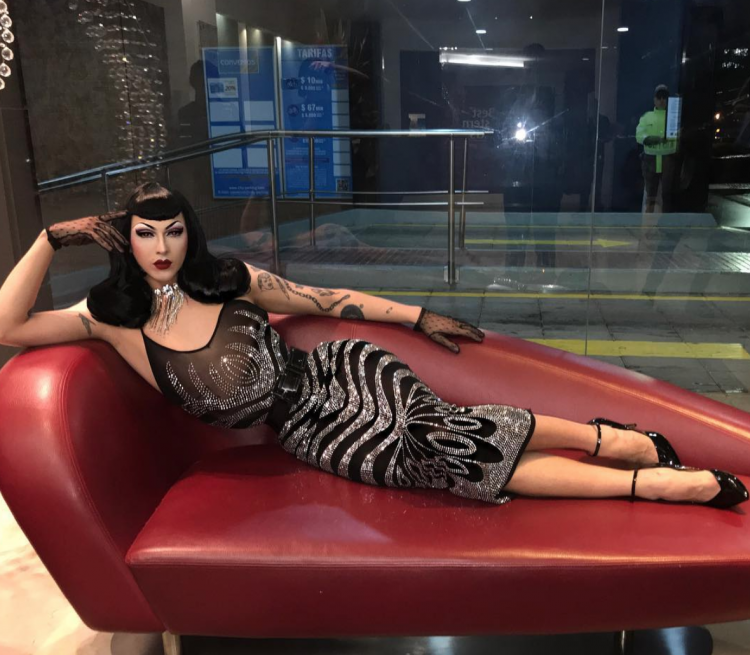Bring It to the (Moschino) Runway: Drag Queens Meet High Fashion

Violet Chachki has been slowly but surely making a name for herself in the fashion world over the past couple of years. She’s modeled in a lingerie campaign, appeared in Prada’s Fall/Winter 2018 advertising campaign, walked the runway for Moschino at Milan Fashion Week, and has been featured in Vogue magazine.
She also just so happens to be a drag queen.
Violet Chachki — the stage name of Jason Dardo, who identifies out of drag as nonbinary — is a 26 year-old drag queen, burlesque artist, and model, who is perhaps most well known for winning season 7 of the reality TV show “RuPaul’s Drag Race.” Since winning her season, Chachki’s fashion sensibilities have earned her the attention of major brands and designers, allowing her to gain a foothold in the high fashion world as no drag queen has done before. She is not, however, the only drag queen who has started to break into the world of mainstream fashion -- fellow Drag Race alumni such as Sasha Velour and Aquaria have also found themselves on the fashion mainstage, with Velour collaborating with New York Fashion Week this past fall to create an Opening Ceremony featuring 40 queer models and performers, and Aquaria being photographed for Vogue Italia and modeling for a Moschina/H&M crossover. And while Chachki fits in quite well with the high fashion world she is more and more often finding herself it, it cannot be denied that she also is bringing something very new and fresh to the various runways and campaigns of these well-established brands - namely, the inherently queer aesthetics that make up the art of drag.
Not very long ago, drag belonged almost purely to the underground. Always (at least in the United States) linked heavily to the LGBTQ community, until recently drag artists and performers could only be found in the clubs (and the occasional comedy making a ‘man in a dress’ gag — see “Mrs. Doubtfire”). Nowadays, with the success of “RuPaul’s Drag Race” bringing drag into the mainstream, dozens of drag queens have been launched into international stardom.
The challenges on the show are diverse, ranging from acting and comedy to design and modeling, allowing the queens competing a chance to show off their particular talents. And showing off an eye for fashion can get you quite far on the show — after all, each episode contains a runway portion. Chachki had many memorable moments on the runway during her time on the show, from her 18-inch corseted waist for the “Death Becomes Her” runway, to her impeccable fall fashion quick change. Doubtlessly, being given a platform to show off her already keen fashion sense attracted the attention of these well-known brands.
Drag queens appearing in high-profile, high-fashion campaigns and runways allows them to not only bring a new aesthetic into these worlds but also brings the arguably inherent gender politics of drag to mainstream runways. One only has to look at Chachki’s Prada campaign, in which she appears dressed as Marilyn Monroe alongside several cisgender female models such as Amanda Murphy and Sarah Paulson — she is not differentiated by the ad itself, but nevertheless stands out due to her slightly-exaggerated (i.e, drag) makeup style, perhaps leading the audience to question their own assumptions about Chachki, and maybe even the other performers surrounding her.
The visual queerness brought to these campaigns by Chachki also offers ever-important representation for queer people who may be watching, something Chachki herself is very aware of — when asked about her experience walking the Moschino runways in an interview with Vogue, Chachki stated “It felt so powerful to be there, especially in the current political climate ... It’s very important to have visual representation, to show that queers are important, queers are powerful, queers are beautiful, queers are valid, and you can’t erase us.”
Drag is revealing of the fact that everything we consider to be markers of gender - clothing, hair, facial features, etc - are all replicable, and thus perhaps aren’t as indicative of an individual’s identity as one much initially think. And bringing that type of art form to a high fashion context shows that these brands may be becoming more willing to break down the restrictive gender roles usually associated with clothing, and embrace the fact that perhaps the over-the-top and transformative aspects of high fashion are actually quite compatible with the gender-fluid performance of drag -- the idea that, as RuPaul says, “we’re all born naked and the rest is drag."







